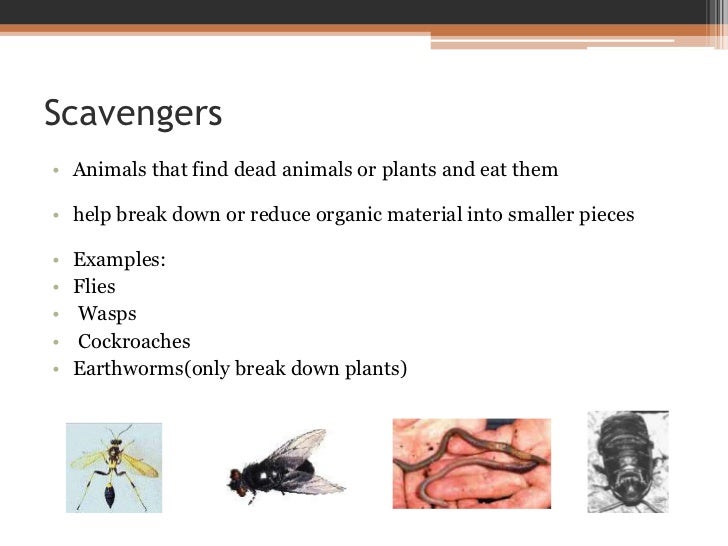

Hyenas are often thought of as scavengers, but are also traditional carnivores. The dead flesh around the wound is eaten, while the animal itself remains relatively healthy. Blowflies often feed on the wounds in sheep, cattle, and other livestock. Animals do not always have to be dead for these scavengers to feast on their decaying flesh. Lammergeiers drop the bones from great heights to break them into smaller pieces, then chew them up to get at the marrow, the soft tissue inside the bones. Rather than eating meat, they survive almost entirely by eating bones. Lammergeiers, or bearded vultures, have more specialized feeding habits than other vultures. This prevents bits of carrion, which can carry toxic bacteria, from sticking to feathers and infecting the bird. Many vultures are also bald, meaning they have no feathers on their head. Raptors use sharp talons and beaks to kill, while vultures do not need to overpower or secure their prey. Unlike raptors, or birds that hunt, vultures have weak talons and beaks. They use these keen senses to locate rotting carrion while they are soaring high over land. Most have excellent eyesight and a strong sense of smell. Vultures have many biological adaptations that make them well-suited to being scavengers. Vultures only eat the bodies of dead animals. Scavengers break down this organic material and recycle it into the ecosystem as nutrients.
Scavengers definition biology free#
They keep an ecosystem free of the bodies of dead animals, or carrion. Scavengers play an important role the food web. Carnivores and omnivores are secondary consumers. Herbivores, carnivores, and omnivores are consumers.

Autotrophs are called producers, because they produce their own food. Scavengers, other carnivores, and omnivores, organisms that consume both plants and animals, are the third trophic level. Herbivores, or organisms that consume plants and other autotrophs, are the second trophic level. Autotrophs, organisms that produce their own food, are the first trophic level. Organisms in the food web are grouped into trophic, or nutritional, levels. Scavengers are a part of the food web, a description of which organisms eat which other organisms in the wild. While most carnivores hunt and kill their prey, scavengers usually consume animals that have either died of natural causes or been killed by another carnivore. Many scavengers are a type of carnivore, which is an organism that eats meat. Indeed it will perhaps always be more advantageous to retain the flexibility of obtaining food by either predation or scavenging.A scavenger is an organism that mostly consumes decaying biomass, such as meat or rotting plant material. So for terrestrial carnivores there is probably no strong selection pressure towards being an exclusive scavenger. In mammals, however, no comparable trade-off occurs. In birds, in order to become exclusive scavengers, vultures have needed to specialize for efficient soaring flight as a low energy form of travel, and as a consequence they have lost the agility needed to kill prey. In the absence of avian radiation, an obligate terrestrial scavenger seems energetically feasible, but we argue that such a beast is unlikely to have evolved. Large individual size is selected for if carrion is available in large packages, when obligate scavenger feed only infrequently, and so must be able to survive on body reserves in the periods between discovering food falls. Soaring was favoured over flapping flight because the reduction in flight speed (and so rate of area search) was more than compensated for by the decrease in the costs of transport. Our model found that aerial scavengers always out-competed postulated terrestrial ones, mainly because flight allows area to be searched much more rapidly for carrion. We use an energetic modelling approach to explore the constraints imposed by an obligate scavenging lifestyle, and to ask whether obligate scavengers must always be avian and generally large-bodied users of soaring flight. Among extant vertebrates, only the 23 species of vulture are obligate scavengers.


 0 kommentar(er)
0 kommentar(er)
